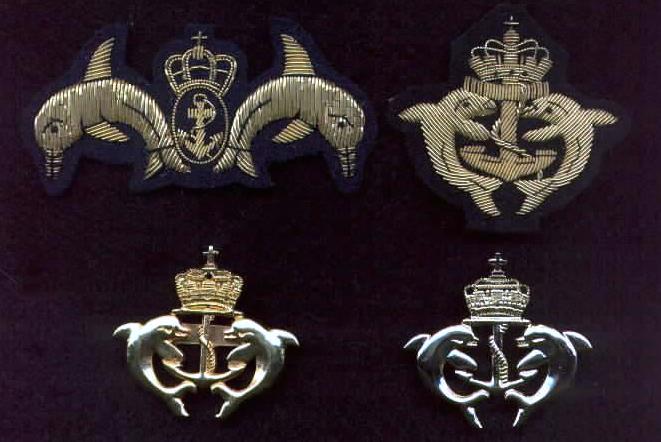|
DENMARK- n 1909, the first Denmark submarine, Dykkeren, was built in La Spezia as a Fiat design. The new Havmanden Class was introduce between 1911 and 1914. There six total, three built in Fiume and three in Copenhagen. The Aegir Class followed in 1917 and shortly thereafter the Rota Class was introduced. The Daphne and newer Havmanden Classes, a smaller class, followed. Copenhagen constructed four new Delfinen Class boats after World War 2. They were eventually replaced in 1980 by two Narvhalen Class subs (based on the German 205 Class) and three Kobben Class subs. These comprise the current Danish Submarine Fleet and are essential coastal boats. The Danish Submarine Badge is worn by all submarine personnel as long as they have completed the Submarine course and served at least 5 months aboard a submarine. The Danish Submarine Force came in contact with other NATO submariners during the late 1960s, they decided they need their own badge. The bullion on the upper left dates to around 1971and is the original design by the Danish Submarine Service. It is a gold bullion of two bottle nose dolphins supporting a cirlced foul anchor and with the Danish Royal Crown atop. It is worn unoffically by Danish submariners on the right breast. The bullion of the upper right is the current submarine badge design in gold bullion. It was authorized in 1973. It is worn by all ranks on the right breast. It has the same element as the other bullion badge but the dolphins are reversed and the anchor is not encircled. This is the primary badges while the metal badges are secondary. The metal badge on the lower left is the offical version. It is worn on the right breast of the sweater or shirt sleeve order. The crown on top is unpierced. The badge is attached by clutch pins. The other metal badge was unoffically issued around 1988. It is the same design as the offical badge but the Royal Crown is pierced. The badge is attached by a horizontal pin back. |

|
ECUADOR- The Ecuador Navy has only recently commissioned submarines as part of their arsenal. They have two German 209 Class (Type 1300), Shyri and Huancavilca. These boats dated from 1977 are based at Guayaquil. Besides some missile boats, they are the central force of the Ecuador Navy. The applique on the Ecuadorian Submarine Badge is from the arms of Ecuador. It consists of the Andean condor encircled by an oval torse all in dull siver metal. The Ecuadorian Submarine Badge is a large German 209 Class submarine in gold placed upon a wreath of two oak boughs. The pewter condor from the National Arms appliqued on the center of the submarine below the sail. The badge comes in four varieties as seen on the right. The only difference is the silver star appliqued on the bow of the sub. The stars each represent five patrols. From top to bottom, represent less than five patrols, followed by less than ten patrols, followed by fifteen patrols, and finally fifteen or more patrols. The badge is worn by all ranks. It is worn on the left breast. |

|
EGYPT- Egypt's submarine started shortly after World War 2 with battle used U.S. and British submarines. The Soviet Union transferred 10 older Whiskey Class submarines to the Egyptian Navy in 1956 after the nationalization of the Suez Canal and Egypt had aligned with this superpower. Eventually six of the Whiskeys were transferred back to the Soviets and replaced with Romeo Class submarines. After Anwar Sadat cut off the Soviets from Egypt in 1972, all of these boats basically sat around and fell ill in repair due to lack of maintenance and availability of parts. Between 1982 and 1986, Egypt ordered some Galerna Class copy of the French Agosta from Spain. However, funds were unavailable and eventually six Romeos were acquired from China who wanted to thumb their nose at Libya (and in turn the Soviet Union). At this time, the Egyptian submarine fleet consists of six Romeo Class submarines and some Swimmer Delivery Vehicles of an Italian design. 2 German 209 Class submarines are on order. The badge for a commanding officer, submarine officer, and enlisted submarine personnel are of the same design as seen to the right. The Only difference is that the Commanding Officer's Submarine Badge is the larger of the three and the Officer's Submarine Badge is larger than the Enlisted Submarine Badge. All of the badges contain the Saladin National Arms on the sail of the submarine. Apparently there is also a seperate badge for Chief Petty Officers. It is the same style as above but it set onto a circle of gold. |

|
ESTONIA- In 1937 Estonia bought two Kalev Class mine laying submarines, Kalev and Lembit, from Vickers Armstrong in Great Britain, which was integrated into the Soviet Navy when they occupied Estonia in 1940. Kalev was sunk off the south coast of Finland during World War 2 while Lembit served until 1979 when it was decommisioned. No badges or distinctives were issued during the 3 years the subs were independent of the Soviet Union. |
| Home Page |